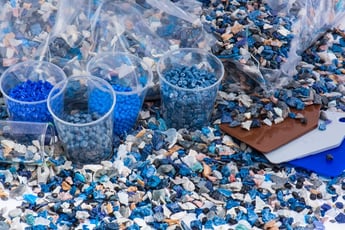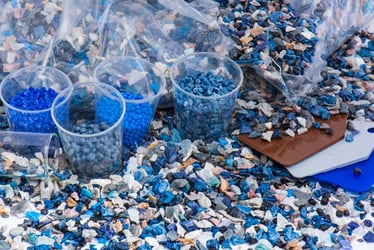
Extrusion companies have special challenges with regrind plastic. Whether it is sheet, tube, or blow in industries such as packaging, tubs, containers or other parts, it is very likely that they operate with machines and large parts. The cuts are inherent to the process and design of the piece and if we add the occurrence of a defect quickly they generate large amounts of regrind. From the beginning of a project consider a percentage of grind that must be reused immediately. So it is good to have grinders at machine level and reincorporate the grinding of the trim plus a percentage of waste. The situation is complicated when more shred or parts are generated than can be used in a given period.
So here are some recommendations so that both production and materials work in a coordinated way:
1. Prevent Generating More Regrind Than You Can Recycle
a. Purge your machines to avoid producing contaminated parts, especially in resin changes, color and starts. Remember that it is more difficult to recover material that is mixed with different polymers, pigments and / or carbon.
b. Perform preventive maintenance on grinders / shredders and train personnel to use them properly. It's common for them to be damaged by dull blades or by saturating them in desperation to grind quickly.
c. If the project is starting, take care to have the lowest percentage of flash (and edge to cut) in the piece, correctly calculate the percentage of waste that it will generate and add a safety number for other reasons, although we do not want them to happen, be sure that sooner or later they will happen. With this data, assure you have enough grinder capacity. Above all, negotiate to add that grind to the finished piece mixed with the virgin.
2. Classification and Conservation
a. Pack it like virgin resin. It is just as valuable. Identify it with the part number, lot, defect, quantity and potential use.
b. Educate staff to know that it is productive resin and that it should not be considered garbage for any reason.
c. Store it in a controlled quarantine area. So you can track it and know how it was used. Obviously if a grind is totally out of specification it must be scrapped out from the plant to avoid further contamination.
3. Use It or Sell It
a. It is best to use this material as soon as possible. If the extruder is a single layer, it must be mixed at a percentage previously agreed with the client. In the case of multi-layer extruders, use it in the hidden layers that have this function.
b. Sell only the grind that you could not use for any reason. Remember that every kilogram of plastic that does not come out as a piece increases the loss.
From experience I can tell that well-preserved regrind can be your salvation in times of scarcity and can sometimes improve the properties of a piece if you know how to use it. The worst thing you can do is: purge with it or contaminate it. Avoid environment contamination by disposing of it in landfills.
Ready to reduce your production downtime to protect your profits? Learn more about how purging compounds and process efficiency work in tandem.

Hector Sanchez, the National Sales Manager at Asaclean - Asahi Kasei Plastics North America, leverages his extensive processing expertise to assist extruders and molders in achieving their operational goals. With a focus on reducing scrap and increasing profits, Hector's in-depth knowledge of Asaclean's Purging Compounds has made him a pivotal figure in the industry. Beyond his primary role, Hector is a dynamic speaker, regularly sharing his insights and strategies at webinars and tradeshows nationwide. His innovative approaches and dedication to customer success have established him as a valued leader and mentor in the plastic industry.







Comments